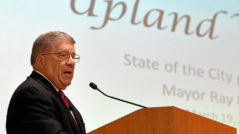Story By Ryan Carter | San Bernardino Sun/Redlands Daily Facts
They can’t take a vote and make it rain, but as they began their spring session last week, Inland Empire legislators were listening to a chorus of local water leaders in their districts, who say they need tools and money to enforce unprecedented water restrictions, build new water infrastructure and preserve the region’s fair share of funding from recent water legislation.
Why should people care?
When it comes to water, preserving it in the Inland Empire comes down to not just survival, but customers’ money, said Assemblywoman Cheryl Brown, D-San Bernardino.
“Their water rates will go off the Richter scale,” she said, referring to the importance of securing funding for a range of measures for the region’s water and its infrastructure.
A day after Gov. Jerry Brown’s historic action to impose mandatory cuts in water use in urban areas around the state, Cheryl Brown met April 2 at her San Bernardino office with a range of water wholesalers, retailers and other agencies, who sounded off.
It was a meeting that had been planned before the governor’s order, but came at a pivotal time.
The state’s vital snowpack is at record lows. And winter came and went this year without much of a dent in historically low rainfall totals.
Cheryl Brown’s goal was to make sure the Inland Empire gets a fair share of drought relief from emergency drought-relief legislation signed March 27 by Gov. Brown. The law will allocate more than $1 billion, which will fund various water projects in the state’s most impacted areas, she said.
“As a region, we need to work together to secure the dedicated funding to protect our water supply,” Cheryl Brown said in a statement. “If we don’t start looking at how we’re going to maximize that funding across the state, we’re going to be left behind.”
Right now, the legislation will add $72 million to the state’s general fund, $272 million to Prop 1, $660 million to Prop 1E and $57 million to various other projects.
Cheryl Brown wanted inland water agencies primed for seeking funding through grants that will become available, she said. And because she has the governor’s ear, she said she could help secure those grants.
What emerged from the roundtable was a series of priorities, officials said.
For one thing, local water districts are concerned about how they will enforce the mandatory cuts.
The governor is seeking a 25 percent reduction in usage, but on Tuesday, the state’s Water Resources Board said that number will fluctuate from area to area, as some localities have already reduced much of their usage and some haven’t.
If water districts don’t hit their water allocation targets, they now face steep fines.
But policing local residents and businesses to make sure they comply with the order is a tall order for some water districts, which rely on small staffs to satisfy the water needs of their respective cities.
“They’re going to expect us to show that we can meet that 25 percent, but without having enforcement tools, how are we going to do that?” said Anthony “Butch” Araiza, general manager of West Valley Water District, which serves the drinking water needs of customers in parts of Rialto, Colton, Fontana, Bloomington and Jurupa Valley, as well as portions of the unincorporated areas of San Bernardino and Riverside counties.
Questions over short-term or long-term funding for staff who enforce water cuts need to be addressed, he said.
Since the governor’s order last week, Inland Empire cities have already been evaluating what measures they’ve put in place to cut water use and what more they can do.
The measures center around cutting use of everyday types of things, like watering lawns.
In Pomona, the City Council will be asked April 20 to approve a new level of conservation measure, beyond the permanent water restrictions in place since 2009, following the last water shortage.
In Upland — where outdoor irrigation accounts for about 75 percent of the city’s water use — officials are already talking about having to “step up their efforts.”
In Ontario, the Public Works Commission reviewed the matter and city staffers are recommending that the city go into Stage III High Water Conservation Alert, from state II, which suggests a whole new level of restrictions and enforcement on residents and businesses.
Enforcement funding is not the only emerging priority for inland water leaders.
Assemblyman Marc Steinorth, R-Rancho Cucamonga, whose 40th District stretches from Rancho Cucamonga east to cities including Highland, said he’s been hearing from constituents, too, many of them in agriculture.
“They are very concerned about having ready access to safe, affordable water,” he said. “They’re focused on making sure we build above-ground water storage.”
Steinorth emphasized the need to avert future water crises by developing a water infrastructure that includes recycling water and desalinization.
“I don’t understand why it’s necessary that we have to use drinking-quality water for our landscaping when … we’re able to use nonpotable water for those applications,” he said.
He’s not the only one who feels that way, as a growing chorus inside and outside of the water industry is calling for measures that emphasize ways to reuse water.
Bob Tincher, who runs the San Bernardino Valley Municipal Water District, said recycling water can be costly, but worth it, as it enables communities not to always rely on new water to meet area needs.
Tincher, whose wholesale water agency sells water to many eastern San Bernardino County communities, also suggested another concern legislators must be aware of: the cost of environmental restrictions, which he said have reduced water “reliability” — a measure used by planners to evaluate dependance on water — by 20 percent.
He suggested to Brown that the Bay Delta Conservation Plan, a long-term, $25 billion plan that seeks to restore the Sacramento-San Joaquin Delta ecosystem and secure California water will help restore water reliability in the state and in the I.E.
That controversial plan is getting a second look, and a potential overhaul, as doubts emerge over whether water exporters can meet tough federal requirements for operating the system over 50 years.
Legislators and water officials alike acknowledged that lifestyle changes will need to come, including rethinking how much water is used simply to water lawns.
“It will change the culture,” Araiza said. “A lot of people are reluctant to do that. But sooner or later we’ve got to do something.”
Read the original post at San Bernardino Sun/Redlands Daily Facts
ABOUT THE AUTHOR
Reach the author at Ryan.Carter@inlandnewspapers.com or follow Ryan on Twitter: @ryinie






